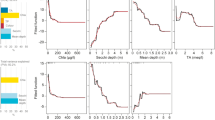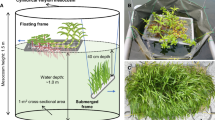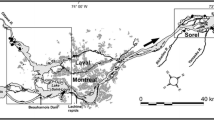Abstract
Shoe Lake and East Graham Lake, part of a small chain of lakes in southeastern Michigan, USA, differ in nutrient loading and in the structure and productivity of their aquatic plant communities. A comparative study of species frequency and biomass distributions, nutrient contents, and responses to experimental nutrient enrichment and shading, was conducted to determine the principal factors controlling the macrophyte dynamics. A central objective was to address the question of why rooted macrophyte growth declines with eutrophication, and to test existing models designed to explain this phenomenon. In the more eutrophic Shoe Lake, diversity and productivity of rooted macrophytes were relatively low, restricted primarily by combined shading of phytoplankton, periphyton, and non-rooted macrophytes (principally Ceratophyllum demersum, along with Utricularia vulgaris and Cladophora fracta). In the less eutrophic East Graham Lake, lower nitrogen availability restricted the growth of all of these shading components, resulting in clearer water and higher productivity and diversity of rooted macrophytes. The macrophytes did not allelopathically suppress the phytoplankton in East Graham Lake. The results supported a direct relationship between nutrient loading, increasing growth of phytoplankton, periphyton and non-rooted macrophytes, and decline of rooted macrophytes.
Similar content being viewed by others
References
Adams, M. S. & R. T. Prentki, 1982. Biology, metabolism and functions of littoral submersed weedbeds of Lake Wingra, Wisconsin, USA: A summary and review. Arch. Hydrobiol. Suppl. 62: 33–409.
Barko, J. W., 1983. The growth of Myriophyllum spicatum L. in relation to selected characteristics of sediment and solution. Aquat. Bot. 15: 91–103.
Barko, J. W. & R. M. Smart, 1979. The nutritional ecology of Cyperus esculentus, an emergent aquatic plant, grown on different sediments. Aquat. Bot. 6: 13–28.
Barko, J. W. & R. M. Smart, 1981. Sediment based nutrition of submersed macrophytes. Aquat. Bot. 10: 339–352.
Best, E. P. H., 1980. Effect of nitrogen on the growth and nitrogenous compounds of Ceratophyllum demersum. Aquat. Bot. 8: 197–206.
Best, E. P. H., D. de Vries & A. Reins, 1984. The macrophytes in the Loosdrecht Lakes: A story of their decline in the course of eutrophication. Verh. int. Ver. Limnol. 22: 868–875.
Bourne, W. S., 1932. Ecological and physiological studies on certain aquatic angiosperms. Contrib. Boyce Thompson Inst. 4: 425–496.
Chapman, V. J., J. M. A. Brown, C. F. Hill & J. L. Carr, 1974. Biology of excessive weed growth in the hydro-electric lakes of the Waitako River, New Zealand. Hydrobiologia 44: 349–367.
Cheney, C. & R. A. Hough, 1983. Factors controlling photosynthetic productivity in a population of Cladophora fracta (Chlorophyta). Ecology 64: 68–77.
Dubois, J. P., G. Blake, P. Gerbeaux & S. Jenser, 1984. Methodology for the study of the distribution of aquatic vegetation in the French alpine lakes. Verh. int. Ver. Limnol. 22: 1036–1039.
Fassett, N. C., 1957. A Manual of Aquatic Plants. U. of Wisconsin Press, Madison, 405 pp.
Filbin, G. J. & J. W. Barko, 1985. Growth and nutrition of submersed macrophytes in a eutrophic Wisconsin impoundment. J. Freshwat. Ecol. 3: 275–285.
Filbin, G. J. & R. A. Hough, 1984. Extraction of 14C-labeled photosynthate from aquatic plants with dimethyl sulfoxide (DMSO). Limnol. Oceanogr. 29: 426–428.
Fornwall, M. D., 1986. The influence of light and inorganic carbon on hydrophyte distribution within two interconnected southeastern Michigan lakes. Dissertation. Wayne State Univ., Detroit, 171 pp.
Fox, D. J. & K. E. Guire, 1976. Documentation for MIDAS. Statistical Research Laboratory, University of Michigan, Ann Arbor, Michigan, USA.
Gerloff, G. C. & P. H. Krombholz, 1966. Tissue analysis as a measure of nutrient availability for growth of angiosperm aquatic plants. Limnol. Oceanogr. 11: 529–537.
Gleason, H. A. & A. Cronquist, 1963. Manual of Vascular Plants of Northeastern United States and Adjacent Canada. D. Van Nostrand, Princeton, 810 pp.
Goulder, R. & D. J. Boatman, 1971. Evidence that nitrogen supply influences the distribution of a freshwater macrophyte, Ceratophyllum demersum. J. Ecol. 59: 783–791.
Grace, J. B. & R. G. Wetzel, 1981. Phenotypic and genotypic components of growth and reproduction in Typha latifolia: experimental studies in marshes of differing successional
Hutchinson, G. E., 1975. A Treatise on Limnology. III. Limnological Botany. John Wiley and Sons, New York, 660 pp.
Jupp, B. P. & D. N. H. Spence, 1977. Limitation on macrophytes in a eutrophic lake, Loch Leven. I. Effects of phytoplankton. J. Ecol. 65: 175–186.
Lachavanne, J. B., 1985. The influence of accelerated eutrophication on the macrophytes of Swiss lakes: Abundance and distribution. Verh. int. Ver. Limnol. 22: 2950–2955.
Manny, B. A., R. G. Wetzel & R. E. Bailey, 1978. Paleolimnological sedimentation of organic carbon, nitrogen, phosphorus, fossil pigments, pollen, and diatoms in a hypereutrophic, hardwater lake: A case history of eutrophication. Pol. Arch. Hydrobiol. 25: 243–267.
Misra, R. D., 1938. Edaphic factors in the distribution of aquatic plants in the English Lakes. J. Ecol. 26: 411–451.
Morgan, N. C., 1970. Changes in the fauna and flora of a nutrient enriched lake. Hydrobiologia 35: 545–553.
Moss, B., 1976. The effects of fertilization and fish on community structure and biomass of aquatic macrophytes and epiphytic algae populations: An ecosystem experiment. J. Ecol. 64: 313–342.
Mulligan, H. F. & A. Baranowski, 1969. Growth of phytoplankton and vascular aquatic plants at different nutrient levels. Verh. int. Ver. Limnol. 17: 802–810.
Mulligan, H. F., A. Baranowski & R. Johnson, 1976. Nitrogen and phosphorus fertilization of aquatic vascular plants and algae in replicated ponds. I. Initial response to fertilization. Hydrobiologia 48: 109–116.
Nichols, D. S. & D. R. Keeney, 1976. Nitrogen nutrition of Myriophyllum spicatum: variation of plant tissue nitrogen concentration with season and site in Lake Wingra. Freshwat. Biol. 6: 137–144.
Nichols, S. A. & B. H. Shaw. 1986. Ecological life histories of the three aquatic nuisance plants, Myriophyllum spicatum, Potamogeton crispus and Elodea canadensis. Hydrobiologia 131: 3–21.
Pearsall, W. H., 1920. The aquatic vegetation of the English Lakes. J. Ecol. 8: 163–199.
Peltier, W. H. & E. B. Welch, 1969. Factors affecting the growth of rooted aquatic plants in a river. Weed Sci. 17: 412–416.
Phillips, G. L., D. F. Eminson & B. Moss, 1978. A mechanism to account for macrophyte decline in progressively eutrophicated freshwaters. Aquat. Bot. 4: 103–126.
Reed, C. F., 1977. History and distribution of Eurasian watermilfoil in United States and Canada. Phytologia 36: 416–436.
Rickett, W. H., 1922. A quantitative study of the larger aquatic plants of Lake Mendota. Trans. Wisconsin Acad. Sci., Arts and Let. 20: 501–527.
Rickett, W. H., 1924. A quantitative study of the large aquatic plants of Green Lake, Wisconsin. Trans. Wisconsin Acad. Sci., Arts and Let. 21: 381–414.
Sand-Jensen, K. & M. Søndergaard, 1981. Phytoplankton and epiphyte development and their shading effect on submerged macrophytes in lakes of different nutrient status. Int. Revue ges. Hydrobiol. 66: 529–552.
Saunders, G. W., F. B. Trama & R. W. Bachmann, 1962. Evaluation of a modified 14C technique for shipboard estimation of photosynthesis in large lakes. Pub. 8, Great Lakes Res. Div., U. of Michigan, Ann Arbor, 61 pp.
Smart, R. M., 1980. Annual changes of nitrogen and phosphorus in two aquatic macrophytes (Nymphaea tuberosa and Ceratophyllum demersum). Hydrobiologia 70: 31–35.
Sneath, P. H. A. & R. R. Sokal, 1973. Numerical taxonomy. W. H. Freeman, San Francisco, 573 pp.
Spence, D. N. H., 1982. The zonation of plants in freshwater lakes. In A. Macfadyen and E. D. Ford (ed.), Advances in Ecological Research. Academic Press, London: 37–125.
Thompson, R. L., 1988. The role of nutrient availability in phytoplankton growth and community structure in a chain of lakes. Thesis. Wayne State University, Detroit, 69 pp.
Toetz, D. W., 1971. Diurnal uptake of N03 and NH4 by a Ceratophyllum periphyton community. Limnol. Oceanogr. 16: 819–822.
Westlake, D. F., 1975. Primary productivity of aquatic macrophytes. In E. Cooper (ed), Primary Productivity of Different Environments. IBP Programme Series No. 3, Cambridge University, Cambridge: 189–206.
Wetzel, R. G., 1973. Productivity investigations of interconnected marl lakes. I. The eight lakes of the Oliver and Walters Chains, northeastern Indiana. Hydrobiol. Stud. 3: 91–143.
Wetzel, R. G., 1979. The role of the littoral zone and detritus in lake metabolism. Arch. Hydrobiol. 13: 145–161.
Wetzel, R. G., 1983. Limnology. Saunders and Co., New York, 760 pp.
Wetzel, R. G. & J. B. Grace, 1983. Aquatic plant communities, In E. R. Lemon (ed), CO2 and Plants: the Response of Plants to Rising Levels of Atmospheric Carbon Dioxide. AAAS Selected Symposium 84, Westview Press Inc., Boulder: 223–280.
Wetzel, R. G. & R. A. Hough, 1973. Productivity and role of aquatic macrophytes in lakes: An assessment. Pol. Arch. Hydrobiol. 20: 9–19.
Wetzel, R. G. & G. E. Likens, 1979. Limnological Analyses. Saunders and Co., New York, 357 pp.
Wilson, L. R., 1935. Lake development and plant succession in Vilas County, Wisconsin. I. The medium hard water lakes. Ecol. Monogr. 5: 207–247.
Wilson, L. R., 1941. The larger aquatic vegetation of Trout Lake, Vilas County, Wisconsin. Trans. Wisconsin Acad. Sci., Arts and Let. 33: 135–146.
Author information
Authors and Affiliations
Rights and permissions
About this article
Cite this article
Hough, R.A., Fornwall, M.D., Negele, B.J. et al. Plant community dynamics in a chain of lakes: principal factors in the decline of rooted macrophytes with eutrophication. Hydrobiologia 173, 199–217 (1989). https://doi.org/10.1007/BF00008968
Received:
Revised:
Accepted:
Issue Date:
DOI: https://doi.org/10.1007/BF00008968




